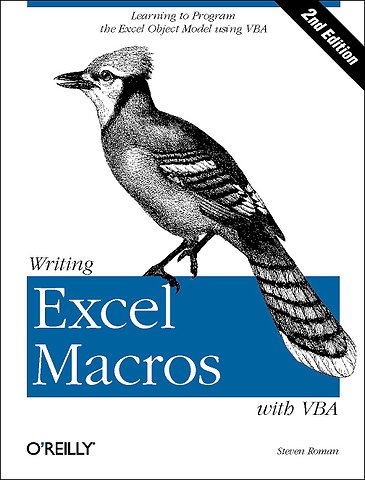Writing Excel Macros with VBA, 2nd Edition
Samenvatting
Newly updated for Excel 2002, 'Writing Excel Macros with VBA, 2nd Edition' provides Excel power-users, as well as programmers who are unfamiliar with the Excel object model, with a solid introduction to writing Visual Basic for Applications (VBA) macros and programs for Excel.
In particular, the book focuses on:
The Visual Basic Editor and the Excel VBA programming environment. Excel features a complete, state-of-the-art integrated development environment for writing, running, testing, and debugging VBA macros.
The VBA programming language, the same programming language used by the other applications in Microsoft Office XP and 2000, as well as by the retail editions of Visual Basic 6.0. The Excel object model, including new objects and new members of existing objects in Excel 2002. Excel exposes nearly all of its functionality through its object model, which is the means by which Excel can be controlled programmatically using VBA. While the Excel object model, with 192 objects, is the second largest among the Office applications, you need to be familiar with only a handful of objects to write effective macros. Writing Excel Macros focuses on these essential objects, but includes a discussion of many more objects as well.
Writing Excel Macros with VBA, 2nd Edition is written in a terse, no-nonsense manner that is characteristic of Steven Roman's straightforward, practical approach. Instead of a slow-paced tutorial with a lot of handholding, Roman offers the essential information about Excel VBA that you must master to write macros effectively. This tutorial is reinforced by interesting and useful examples that solve common problems you're sure to have encountered.
'Writing Excel Macros with VBA, 2nd Edition' is the book you need to delve into the basics of Excel VBA programming, enabling you to increase your power and productivity
Specificaties
Inhoudsopgave
1. Introduction
Selecting Special Cells
Setting a Chart's Data Point Labels
Topics in Learning Excel Programming
Part I. The VBA Environment
2. Preliminaries
What Is a Programming Language?
Programming Style
3. The Visual Basic Editor, Part I
The Project Window
The Properties Window
The Code Window
The Immediate Window
Arranging Windows
4. The Visual Basic Editor, Part II
Navigating the IDE
Getting Help
Creating a Procedure
Run Time, Design Time, and Break Mode
Errors
Debugging
Macros
Part II. The VBA Programming Language
5. Variables, Data Types, and Constants
Comments
Line Continuation
Constants
Variables and Data Types
VBA Operators
6. Functions and Subroutines
Calling Functions
Calling Subroutines
Parameters and Arguments
Exiting a Procedure
Public and Private Procedures
Project References
7. Built-in Functions and Statements
The MsgBox Function
The InputBox Function
VBA String Functions
Miscellaneous Functions and Statements
Handling Errors in Code
8. Control Statements
The If-Then Statement
The For Loop
The For Each Loop
The Do Loop
The Select Case Statement
A Final Note on VBA
Part III. Excel Applications and the Excel Object Model
9. Object Models
Objects, Properties, and Methods
Collection Objects
Object Model Hierarchies
Object Model Syntax
Object Variables
10. Excel Applications
Providing Access to an Application's Features
Where to Store an Application
An Example Add-In
11. Excel Events
The EnableEvents Property
Events and the Excel Object Model
Accessing an Event Procedure
Worksheet Events
WorkBook Events
Chart Events
Application Events
QueryTable Refresh Events
12. Custom Menus and Toolbars
Menus and Toolbars: An Overview
The CommandBars Collection
Creating a New Menu Bar or Toolbar
Command-Bar Controls
Built-in Command-Bar-Control IDs
Example: Creating a Menu
Example: Creating a Toolbar
Example: Adding an Item to an Existing Menu
Augmenting the SRXUtils Application
13. Built-In Dialog Boxes
The Show Method
14. Custom Dialog Boxes
What Is a UserForm Object?
Creating a UserForm Object
ActiveX Controls
Adding UserForm Code
Excel's Standard Controls
Example: The ActivateSheet Utility
ActiveX Controls on Worksheets
15. The Excel Object Model
A Perspective on the Excel Object Model
Excel Enums
The VBA Object Browser
16. The Application Object
Properties and Methods of the Application Object
Children of the Application Object
17. The Workbook Object
The Workbooks Collection
The Workbook Object
Children of the Workbook Object
Example: Sorting Sheets in a Workbook
18. The Worksheet Object
Properties and Methods of the Worksheet Object
Children of the Worksheet Object
Protection in Excel XP
Example: Printing Sheets
19. The Range Object
The Range Object as a Collection
Defining a Range Object
Additional Members of the Range Object
Children of the Range Object
Example: Getting the Used Range
Example: Selecting Special Cells
20. Pivot Tables
Pivot Tables
The PivotTable Wizard
The PivotTableWizard Method
The PivotTable Object
Properties and Methods of the PivotTable Object
Children of the PivotTable Object
The PivotField Object
The PivotCache Object
The PivotItem Object
PivotCell and PivotItemList Objects
Calculated Items and Calculated Fields
Example: Printing Pivot Tables
21. The Chart Object
Chart Objects and ChartObject Objects
Creating a Chart
Chart Types
Children of the Chart Object
The Axes Collection
The Axis Object
The ChartArea Object
The ChartGroup Object
The ChartTitle Object
The DataTable Object
The Floor Object
The Legend Object
The PageSetup Object
The PlotArea Object
The Series Object
Properties and Methods of the Chart Object
Example: Scrolling Through Chart Types
Example: Printing Embedded Charts
Example: Setting Data Series Labels
22. Smart Tags
What Are Smart Tags?
SmartTagRecognizer Object
SmartTag Object
SmartTagAction Object
SmartTagOptions Object
Part IV. Appendixes
A. The Shape Object
B. Getting the Installed Printers
C. Command Bar Controls
D. Face IDs
E. Programming Excelfrom Another Application
F. High-Level and Low-Level Languages
G. New Objects in Excel XP
Index
Anderen die dit boek kochten, kochten ook
Net verschenen
Rubrieken
- aanbestedingsrecht
- aansprakelijkheids- en verzekeringsrecht
- accountancy
- algemeen juridisch
- arbeidsrecht
- bank- en effectenrecht
- bestuursrecht
- bouwrecht
- burgerlijk recht en procesrecht
- europees-internationaal recht
- fiscaal recht
- gezondheidsrecht
- insolventierecht
- intellectuele eigendom en ict-recht
- management
- mens en maatschappij
- milieu- en omgevingsrecht
- notarieel recht
- ondernemingsrecht
- pensioenrecht
- personen- en familierecht
- sociale zekerheidsrecht
- staatsrecht
- strafrecht en criminologie
- vastgoed- en huurrecht
- vreemdelingenrecht







